How “Clean Energy First” Would Increase Electricity Rates for Xcel Customers
Last session, the Minnesota legislature considered passing legislation called Clean Energy First (CEF). This bill, as the name suggests, would mandate utility companies in Minnesota to prioritize renewable and carbon-free energy sources over traditional energy sources when building a new power plant.
Clean Energy First, in this way, is an extension of the renewable energy goals within the Next Generation Energy Act (NGEA) passed in 2007, which has resulted in a tremendous increase in the cost of electricity in Minnesota.
In fact, this legislation has all but eliminated the state’s price advantage compared to the national average. The graph below shows residential electricity rates for Minnesota households surpassing that of the national average in recent years.
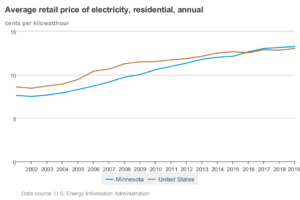
If passed, CEF would allow utilities like Xcel Energy to increase rates even more than the NGEA by green-lighting future plans to reach renewable energy targets in the most expensive way possible.
Xcel is currently planning to close its coal plants decades before the end of their useful lifetime and replace them with a massive buildout of solar, wind, and natural gas. As of right now, it is uncertain whether government regulators will improve this plan due to its high cost. The passage of CEF into law, however, would pave the way for this plan by making it easier to approve such an expensive approach to electricity in the name of “clean energy.”
As a result, Xcel’s current plan, under CEF provisions, would increase electricity costs by $46 billion through 2050, translating into an average increase of $1,200 per year for each and every one of Xcel’s residential, commercial, and industrial customers.
How do we know this?
We calculated the cost using the exact numbers Xcel submitted to the Public Utilities Commission. This includes power plant additions and retirements, capacity factor ratings for different energy sources, the cost of generation from those sources, and power purchase agreements (PPA) found in resource documents going through 2050, and weighed them against the provisions in CEF to obtain our results.
For the cost of building each energy source, we used regional costs listed in Energy Information Administration’s (EIAs) “Assumptions to the Annual Energy Outlook 2020: Electricity Market Module.”
Below, I detail more about how Clean Energy First and Xcel Energy’s resource plan would increase electric bills by $1,200 per year per Xcel customer.
1. The Most Alarming (and Expensive) Provision in Clean Energy First
While CEF has a number of provisions that will result in higher electricity rates, none is more troublesome than the following:
“If the commission approves a resource plan that includes the retirement of a carbon-emitting resource owned by a public utility, the public utility shall be entitled to own the generation, transmission, and other facilities necessary to replace the accredited capacity and energy of the retiring facility.”
This may seem like a pretty standard provision, one that is simply allowing for the replacement of retiring generation… but not for those familiar with how utilities make money.
Public utility companies – such as Xcel – don’t make money through electricity sales. Rather, utilities earn a profit by charging a “rate of return” of usually 10 percent on undepreciated assets, which include power facilities that the utility owns and are still paying off capital investments. Utility companies then factor these return values into the “revenue requirement” they charge ratepayers (electricity rates).
As Figure 2 demonstrates, once a power facility is fully depreciated, it starts producing the most affordable electricity it will ever produce. Utility companies, however, no longer earn a return on this asset. As such, utilities like Xcel have a tremendous incentive to retire this generation in favor of new, expensive, and undepreciated assets that they can earn profit from.
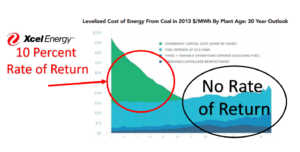
With this in mind, the disastrous implications of this provision in Clean Energy First – of utilities using it to pad their profits at the expense of ratepayers – becomes clear.
Under the current language, Xcel would be allowed to prematurely close power facilities it is no longer receiving profits from (i.e. low-cost coal facilities that are fully depreciated and can no longer earn a rate of return) with a simple approval from the Public Utilities Commission (PUC).
As long as Xcel’s resource plan shows the intention of reducing reduce carbon emissions by 80 percent – the exact amount Xcel promises to reduce in their resource plan – and “demonstrates its ownership of replacement resources is in the public interest, considering customer impacts and benefits,” CEF would allow Xcel to then replace these coal facilities with more expensive and less reliable renewable energy facilities that it would be able to make a profit from for decades to come at the expense of ratepayers.
Unfortunately for over 1 million customers that Xcel serves, the utility company has put this exact nightmare scenario into action in its most recent resource plan.
To begin, after promising to achieve an “80 percent carbon reduction by 2030,” meeting the language outlined by the bill, Xcel asks the PUC to approve the premature retirement of the rest of its coal facilities – Allen S. King “nine years early” in 2028, and Sherburne County “ten years early” in 2030 – bringing the total coal capacity Xcel plans to retire to about 2,400 MW by 2030.
These facilities are still churning out affordable electricity at around $35 per megawatt-hour (MWh), according to form 1 filings submitted by Xcel to the Federal Energy Regulatory Commission (FERC). Nonetheless, these plants are no longer earning Xcel a profit due to being fully depreciated assets.
The utility plans to replace retiring coal capacity with 4,000 MW of utility-scale solar, 1,800 MW of wind energy, and over 2,500 MW of natural gas and other “firm” capacity in the coming years – all of which Xcel will be able to earn a rate of return from.
The “clean energy” movement, in this way, plays directly into the hands of large utility companies, which are being allowed to profit massively from it.
Replacing 2,400 MW of inexpensive existing coal power with over 8,000 MW of combined new wind, solar, and natural gas – more than a three-to-one capacity replacement – is a significant portion of the $46 billion investment that Xcel plans to charge ratepayers through 2050.
The need for a three-to-one replacement is also explained by Xcel in its resource plan:
“As variable resources [wind and solar energy] are dependent on natural resource availability in a given moment (i.e. wind blowing or sun shining), their capacity does not replace retiring dispatchable units one-for-one in terms of the amount of energy it produces, or assurance that this capacity will produce energy when needed.” [Emphasis added]
Xcel is essentially arguing that 2,500 MW of “firm” capacity will be needed to replace 2,400 MW of retiring coal, in addition to nearly 6,000 MW of additional renewable energy, out of the need to maintain reliability in the absence of coal power and the presence of unreliable wind and solar power.
So, the plan is basically to exchange coal for natural gas with a premium of renewable energy added on top.
Xcel’s resource plan will result in excess capacity of nearly 6,000 MW compared to today, producing power for the same level of electricity demand as before (and perhaps lower) as the two graphs below show.
Figure 3 shows Xcel’s energy mix growing from about 8,000 MW to nearly 14,000 MW, while Figure 4 shows Xcel’s forecast for electricity demand through 2034 as decreasing.
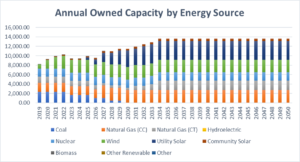
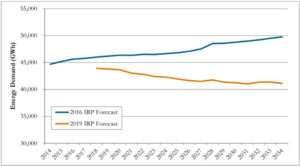
2. Misunderstanding LCOE Values
Clean Energy First is also operating on false assumptions about Levelized Cost of Energy (LCOE) values.
LCOE is a common measurement of the lifetime cost to operate different power plant technologies (coal, natural gas, nuclear, wind, solar, biomass, etc.).
However, comparing between dispatchable (fuel-based) resources, and non-dispatchable (intermittent renewable) resources, as the backers of Clean Energy First did, is not advisable according to the Energy Information Administration (EIA).
As EIA notes:
“Because load must be continuously balanced, generating units with the capability to vary output to follow demand generally have more value to a system than less flexible units (nondispatchable technologies) that use intermittent resources to operate. The LCOE values for dispatchable and non-dispatchable technologies are listed separately in the following tables because comparing them must be done carefully.”
Furthermore, comparing LCOE values of new generation resources is valuable when we are considering new power plants needed to meet growing electricity demand in Minnesota. But, as Figure 4 shows above, Xcel isn’t expecting substantial growth in demand – and certainly not enough growth to justify a massive capacity increase of 6,000 MW.
The energy debate in Minnesota today is quite different than it has been in the past. What we are considering now is the replacement of existing generation resources – which are much more affordable than new power facilities – with new power facilities that are more expensive and less reliable, but can fulfill the desire to curb CO2 emissions. This task requires the comparison between the cost of existing resources seeking to be replaced with that of new resources brought in to replace them.
Rather than coal operating at $66 per MWh in Minnesota, as the backers of CEF suggest (which is really the cost of a brand new coal facility), existing coal plants owned by Xcel produce electricity at around $35 per MWh, based on FERC form 1 filings.
There is simply no economic argument for preferring wind and solar over existing coal power in Minnesota. Period.
Based on our modeling, LCOE values for Xcel’s resource plan through 2050 look more like this:

New LCOE values for wind and solar are based on the following in-service LCOE values provided by Xcel, as well as the in-service schedule of new capacity additions provided by Xcel’s most recent resource plan.
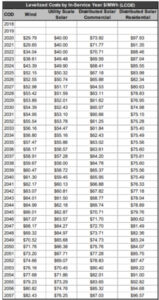
As you can see, the Levelized Generation cost of new wind and solar energy sources alone, $58.38 and $51.56 per MWh, respectively, is already higher than existing LCOE values of coal at $37.86, combined cycled natural gas at $36.93, nuclear at $35.87, and hydro at $20.68 per MWh.
After accounting for additional levelized costs, such as property taxes, transmission expenses, utility profits, and load balancing, the total cost of new wind and solar grows to $103.01 and $140.39 per MWh, respectively, widening the gap between the cost of existing and new generation resources even further.
Due to the retiring of affordable power plants in favor of incredibly expensive wind and solar facilities, operating costs become one of the most substantial additional costs stemming from Xcel’s proposed resource plan, as Figure 7 shows below. (Gray bar).
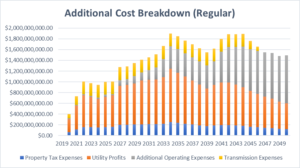
The fact is simple: new generation facilities are much more expensive than existing, fully depreciated power plants.
By comparing new LCOE values across dispatchable and non-dispatchable technologies and without considering existing sources, it’s clear that the assumptions used to argue in favor of Clean Energy First are misguided and incomplete.
3. The High Cost of Repowering
Wind and solar facilities, as opposed to fuel-based generators, never reach a point where they operate past being fully depreciated. This is because these facilities only last for 20 to 25 years, respectively, and they need to be repowered or scrapped entirely either before or soon after.
Thus, in order to maintain renewable fleets, there is a constant need for capital reinvestment. This means that electricity rates are never able to decrease, and expenses remain high for years to come.
Repowering wind turbines requires the complete destruction and rebuilding of the turbine from the ground up, whereas for solar, it entails installing entirely new panels. The old turbine blades are sent to landfills, and old solar panels are often sent to developing nations for disposal.

This means that a plan like Xcel’s to go to 50 percent renewable energy doesn’t end at the initial investment – which is one of the reasons why we model out to 2050 to see how repowering plays a role in future costs.
For example, in addition to the over 8,000 MW of new capacity Xcel has proposed to replace coal generation, Xcel also plans to repower around 1,200 MW of wind through the end of 2034 as part of its “no going back” policy on wind energy. However, our model shows that through 2050, the total will reach closer to 4,045 MW.
The capital cost alone for repowering these wind turbines exceeds $4 billion and is a major contributor to the $46 billion additional investment that Xcel will force Minnesota families and businesses to pay if its proposed resource plan is approved by the PUC, and CEF is signed into law.
The graph below shows the average annual increase in electricity rates based on this plan:
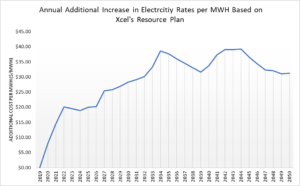
Notice that rates never drop back to previous levels due to the simultaneous elimination of inexpensive power plants and the continued investment needed to keep wind and solar farms in the ground and operating.
Compare this to the 1990s, as Figure 10 shows below, when the benefit of utilizing fully depreciated fuel-based power facilities allowed electricity rates to decrease 21 percent from 1990 to 2003. Only when Minnesota began investing heavily in renewable energy sources did electricity rates begin to rise again.
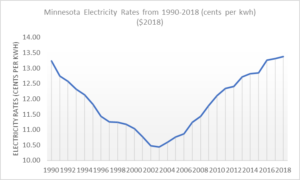
4. No Additional Assurances That Rates and Bills Will Be Considered in CEF
Seeing as how Clean Energy First, as it is, can potentially lead to enormous cost increases for Minnesota ratepayers, it would be nice to see an inclusion of a price cap on renewable energy investments, as other states have done in the past.
Unfortunately, there are no additional assurances in CEF that electricity costs will be kept low. It includes the same “just and reasonable” language as before, entrusting the same body (the Public Utilities Commission) as before, that have both resulted in electricity rates increasing by 25 percent since 2004, as shown in figure 10 above, in inflation-adjusted numbers.
Frankly, any language that doesn’t put a direct, clear cap on the cost of renewable energy investments, or a limit of some kind on rate increases, simply isn’t good enough.
If costs are to be kept low, then real assurances need to be made to make it so.
Not the Bill for Minnesota
Clean Energy First – outed by the very choice of its name – is anything but letting the free market speak for itself.
And the market has very clear answers for us: fuel-based power facilities are more reliable and valuable to an electrical grid than intermittent, renewable energy sources. Not only that, but fuel-based energy sources also provide more opportunities for cost-savings down the road. Wind and solar, on the other hand, are dependent on government subsidies to thrive and require constant reinvestment to maintain.
Without the government playing favorites, wind and solar would not be in the position they are in today.
Utilities in the U.S., for their part, seem to agree through their actions. A new study by the Lawrence Berkeley National Labs found the production of wind turbines falls off dramatically after 10 years, which is when they can no longer help themselves to federal subsidies.

It’s about time Minnesota energy policies weren’t driven by the hopes, wishes, and misleading advice of renewable energy advocates on the one hand, and the opportunism of utility companies on the other, and started working in the benefit of the Minnesotan ratepayer as it was intended.